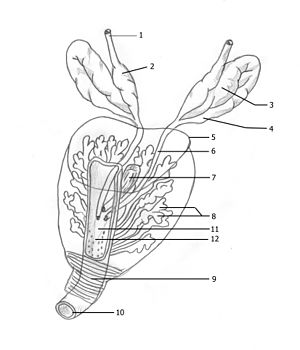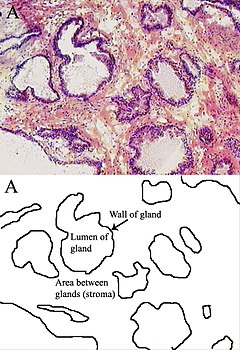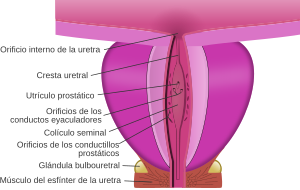Prostate
The prostate (from the ancient Greek προστάτης, prostátēs, literally "the one in front", "protector", "guardian") is a glandular organ of the male reproductive in the vast majority of mammals, chestnut-shaped, located in front of the rectum, below and in contact with the urinary bladder and surrounding the origin of the urine tube (urethra).
During ejaculation, this organ receives sperm from the vas deferens, mixed with its own secretions, from the seminal vesicles and Cowper's glands, which it expels through the urethra to the outside.
The prostate gland provides:
- Antigen
- Fibrinogen
- Spermina
- Zinc (Zn, bactericidal properties)
- Magnesium (Mg, gives a milky look to semen)
- Enzymes:
- Acid phosphatase
- Fibrinolisine
- Transglutaminese (in rodents, densifies the semen so that it generates a vaginal plug, avoiding the discharge of the semen, as well as the copule by another male).
Just above and to the sides of the Prostate are the seminal vesicles, which produce most of the seminal fluid.
Male hormones stimulate the prostate gland from the development of the fetus. The prostate continues to grow until adulthood is reached and maintains its size while male hormones are produced. If the male hormones disappear, the prostate gland cannot develop and shrinks in size, sometimes almost disappearing.
The prostate is homologous, in its embryonic origin and in its physiology, to Skene's glands in women.
Features
The prostate is a glandular organ, it produces a liquid secretion that is part of the semen, an adequate medium for the survival of the spermatozoa. The functional structure of the prostate is the acinus, made up of epithelial cells and stromal cells, separated by a basement membrane. In glandular epithelial cells, prostate-specific antigen (PSA) and acid phosphatase are produced and secreted.
Anatomy
The prostate in men is located in the pelvis, below and in contact with the urinary bladder and surrounding the origin of the urine conduit (urethra), it is in front of the rectum, above the pelvic floor.
The dimensions of the human Prostate are ≈3.5 centimeters in diameter at its base in contact with the bladder and the anterior-posterior and top-bottom diameters of ≈2.5 centimeters.
Lymphatic drainage
Lymphatic drainage of the prostate is carried out through lymphatic vessels that drain on the outer surface of the prostate, forming the periprostatic network, which drains both in the nodes of the external iliac chain and in the in sacral ganglia and hypogastric ganglia.
Zones of the prostate
Several areas can be distinguished in the prostate, but the most important sonographically are:
- Fibromuscular estroma; it extends posterolaterally and forms the capsule.
- The transitional zone, next to the prostatic utricle and the periuretral glandular tissue. It's seat of prostate hyperplasia.
- The central area, which surrounds the transition zone.
- The peripheral or marginal area, where cancer is usually located, occupies 75% of the total volume.

1. Deferential behavior.
2. Ampoule of the deferent duct.
3. Seminal vesicle.
4. Excretor of the seminal vesicle.
5. Prostate contour.
6. Ejaculating behavior.
7. Prostatic uric.
8. A glandular substance.
9. Uretra sphincter.
10. Uretra.
11. Seminal car.
12. Uretral cream.
Male sexual response
During orgasm, sperm is transmitted from the vas deferens to the urethra, through the ejaculatory ducts that enter the prostate. Men are able to ejaculate through stimulation of the prostate, through a prostate massage; which is used in hospitals to obtain rapid semen samples without the need for sexual stimulation or masturbation.
Exploration
The prostate is felt by the doctor on physical examination using rectal examination. The imaging tests that visualize the prostate are mainly transrectal ultrasound, computerized axial tomography and nuclear magnetic resonance.
Most common diseases
The most frequent diseases of the prostate are:
- Prostatitis. It's an inflammation of the prostate. It can be infectious or not. It may cause symptoms of urinary infection, but with negative urocultives. Acute prostatitis can be caused by sexually transmitted diseases. They often give many symptoms and even fever. Chronic prostatitis usually sits in large prostates, people over 50 years old with benign prostatic hypertrophy. Symptoms usually go unnoticed. Antibiotic treatment usually takes weeks in prostatitis.
- Benign prostate hyperplasia, Benign Prostatic Hyperplasia (BPH) or prostatic adenoma. It is not cancer, but growth of the organ (unlike most, who tend to atrophy with age) until they become hypertrophy. They are normal changes that the prostate suffers in men as they age. It can cause symptoms of bladder irritation, such as urination, lower strength in the urine jet, or urinate repeatedly; this is called prostatism. It has different complications, such as urinary repetition infections, complete urinary retention, kidney failure, hematuria and bladder litiasis.
- Prostate cancer. It's very common in men. Studies corroborate their presence in older men through a prostate biopsy. In most men gradually evolve (death for natural causes many years later) without the cancer affecting their quality of life. In a few cases the cancer is aggressive. According to the stage of neoplasia, treatments range from surgery and radiation therapy for curative purposes to palliative treatments with hormonotherapy and chemotherapy.
World Day Against Prostate Cancer
September 15 marks the International Prostate Health Day. The objective of this World Day against Prostate Cancer is to influence the need for regular check-ups with the urologist, since 90% of new cases of prostate cancer are diagnosed in these check-ups.
Contenido relacionado
Nymphaeaceae
Early detection
Clinical neurophysiology



